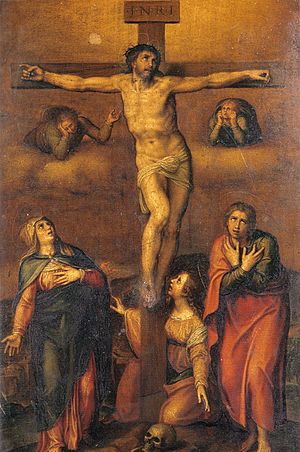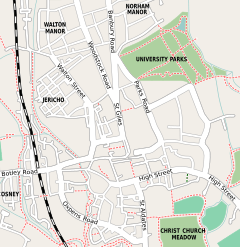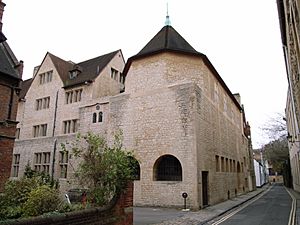Campion Hall, Oxford facts for kids
Quick facts for kids Campion Hall |
|||||||||||||
|---|---|---|---|---|---|---|---|---|---|---|---|---|---|

Blazon: Argent on a cross sable a plate charged with a wolf's head erased of the second between in pale two billets of the field that in chief charged with a cinquefoil and that in base with a saltire gules and in fesse as many plates each charged with a campion flower leaved and slipped proper on a chief also of the second two branches of palm in saltire enfiled with a celestial crown or.
|
|||||||||||||
|
|
|||||||||||||
| University | University of Oxford | ||||||||||||
| Location | Brewer Street, Oxford | ||||||||||||
| Coordinates | 51°44′59″N 1°15′30″W / 51.7496°N 1.2582°W | ||||||||||||
| Founder | Richard Clarke SJ | ||||||||||||
| Established | 1896 | ||||||||||||
| Named after | Edmund Campion | ||||||||||||
| Master | Nicholas Austin SJ | ||||||||||||
| Postgraduates | 15 | ||||||||||||
| Website | campion.ox.ac.uk | ||||||||||||
| Map | |||||||||||||
Campion Hall is a special place at the University of Oxford in England. It's one of four "permanent private halls." Think of it like a smaller, unique college.
It's run by the Society of Jesus, also known as the Jesuits, who are a group within the Catholic Church. The hall is named after Edmund Campion, a famous Jesuit who lived a long time ago.
You can find Campion Hall on Brewer Street in Oxford. It's located right between two other well-known colleges: Christ Church and Pembroke College. Many of its buildings and even some of the furniture were designed by a famous architect named Sir Edwin Lutyens.
The hall also has a cool collection of religious art. These artworks are over 600 years old! Most of them were gathered by a person named Fr Martin D'Arcy in the 1930s.
Contents
History of Campion Hall
How Campion Hall Started
Campion Hall began on September 9, 1896. A man named Fr Richard Clarke, who used to study at Oxford, opened a small place called Clarke's Hall. He was sent to Oxford to create a hall where Jesuit students could study at the university.
He started with a small house and was the first leader, or "master," of the hall. On September 10, 1896, the hall welcomed its first four students. This allowed Jesuits to get degrees from the University of Oxford.
The first place they rented was too small. So, after about 15 months, the hall moved to a bigger building called Middleton Hall.
New Names and Permanent Status
In 1900, Fr Clarke passed away. The hall then reopened as Pope's Hall, named after its new master, Fr O'Fallon Pope. He bought more buildings nearby to make the hall bigger.
Later, Fr Charles Plater became the master, and the hall changed its name again to Plater's Hall.
In 1918, the hall became a "permanent private hall." This meant it had a special, lasting place within the University of Oxford. It was renamed Campion Hall after St Edmund Campion. These permanent halls are not for making money. They have the same benefits as the bigger colleges at Oxford.
After Fr Plater, other masters led Campion Hall, including Fr Henry Keane and Fr Ernest G. Vignaux. Then, Fr Martin D'Arcy became master in 1933.
Moving to Brewer Street
In 1933, the lease on the old buildings was ending. So, Campion Hall decided to find a new home. They found a great spot on Brewer Street. The old properties were then sold to St. John's College.
Brewer Street has a long history. In the past, it was known for brewers and butchers. Oxford used to have many breweries, and some colleges even had their own!
At Brewer Street, Campion Hall bought two buildings. One was an old lodging house. The other was a garage that used to be stables for horses that pulled Oxford trams. The garage was taken down, and parts of the old house were used in the new design.
The famous architect Sir Edwin Lutyens designed the new building. It was finished in 1936. This is the only building in Oxford designed by Lutyens. The building's style looks a bit like old 17th-century buildings from the Cotswolds.
The chapel inside Campion Hall is very special. Lutyens even designed unique light fittings for it. He also used a special architectural style he created for New Delhi, India, in the chapel's columns.
Fr. D'Arcy continued to lead Campion Hall until 1945. Later, in 2001, a Jesuit magazine called The Way started working from Campion Hall.
Today, Campion Hall is a home for Jesuit scholars at Oxford. It welcomes students from all over the world. They study subjects like humanities and social sciences.
In 2018, the Laudato Si' Research Institute began at Campion Hall. This institute focuses on studying environmental issues.
A Possible Lost Masterpiece

In 2011, a painting hanging in Campion Hall caused a lot of excitement. It was a painting called "The Crucifixion of Jesus". Some people thought it might be a long-lost masterpiece by the famous artist Michelangelo! If true, it could be worth a huge amount of money.
Fr. Martin D'Arcy had bought the painting at an auction in the 1930s. However, some art experts believe it might have been painted by Marcello Venusti, one of Michelangelo's students. They think it was made later in Michelangelo's life when his eyesight was not as good.
The painting was moved from Campion Hall. Now, you can see it on display at the Ashmolean Museum in Oxford.
The Way Journal
The Way is a journal about Christian spirituality. It publishes articles four times a year for people around the world. The journal is based at Campion Hall.
It was started in 1961 by James Walsh. Over the years, it moved to different locations. In 2001, it finally moved to Campion Hall.
Laudato Si' Research Institute
The Laudato Si' Research Institute is also based at Campion Hall. It started in 2018. The institute is named after a special letter from Pope Francis called "Laudato si'".
Its director, Celia Deane-Drummond, founded it. The institute does research on environmental problems in the world. It works with a master's degree program in London that focuses on theology, ecology, and ethics. The institute is also building a network to help researchers around the world work together on environmental topics.
Masters of Campion Hall
|
|



